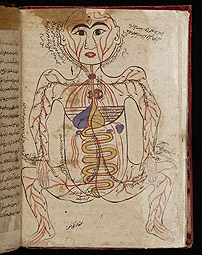 |
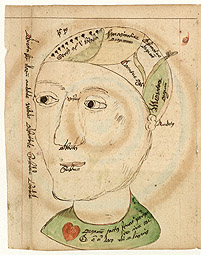
 |
 |
The Cosmic Mind, Germany, 1400s
|
 |
In this exhibition, the Getty Research Institute presents highlights from the an extraordinary collection of illustrated manuscripts. Displayed together publicly for the first time, these manuscripts on the history of science and ideas demonstrate the circulation of knowledge around the world and across cultures during the medieval and early modern periods. Medieval Muslim and Christian medicine, Chinese acupuncture, secret experiments in alchemical laboratories, codebooks for keeping secrets secret, and French and Persian visions of the cosmos that blend science with spirituality are among the treasures on display. These manuscripts were produced for caliphs, popes, merchants, and scientists. Copied and illustrated by hand, their contents—their ideas and visions—illustrate the human urge for knowledge and creative invention.
|
 |
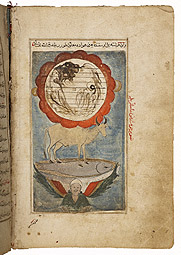
 |
 |
Mass of the Earth Supported by an Ox Floating on the Ocean, Azerbaijan, 1552
|
 |
 |
The division between science and religion is a modern one. In the medieval and early modern periods, scientific study was often viewed as a form of spirituality, a vehicle for knowing an unknowable god. Study of the stars, exploration of the earth, the abstract orders of music and mathematics, and the philosophical search for truth and certainty all supported rather than challenged belief in God. The concept that man was made in God's image extended to the belief that human creativity imitates divine creative acts. Thus, art imitates nature.
The image at the top of this page is a diagram of the human "cerebrum" that locates the mental faculties of reason, memory, fantasy, cognition, and the senses. This construction of the mind was believed to mirror the structure of the cosmos.
The sensationalist, illustrated narrative in the book above, at left, traces the creation and evolution of celestial and terrestrial life; it quickly became one of the most popular scientific digests in the Islamic world. Zakariya ibn Muammad al-Qazwini's Creatures and Phenomena Marvelous and Strange has at its core a moralizing standpoint that glorifies the wondrous nature of God's creativity and its structured order.
|
 |
|
Medieval physicians debated theories of how the human body could be influenced, adjusted, and repaired by external physical factors, including forces exerted by the planets and stars, and the herbs and minerals found on Earth.
Celestial medicine, which charted the effects of the heavenly bodies on the activity of the human body, identified opportune moments in astral cycles for medical procedures. Herbal remedies were offered in manuscripts with illustrated instructions on the identification of plants and the medical effects on the human body that could be distilled from their essences. Meanwhile, advancements in the study of anatomy throughout Europe and Asia allowed physicians to repair the human body through techniques such as surgery and acupuncture.
One of the earliest known illustrations of human anatomy in the Islamic world appears in this standard "desk reference," above, for Arabic and Persian physicians. The color-coding of veins and arteries as blue and red is preserved in today's culture by the spiraling blue, red, and white stripes of a barber's pole, harking back to the days of the barber-surgeon in the Middle Ages.
|
 |
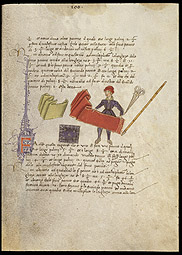
 |
 |
Measuring the Length of Cloth or the Volume of a Wine Cask, Italy, 1478
|
 |
 |
Knowledge, like commodities such as grain and pepper, circulated between East and West. Classical Greek texts on Euclidean geometry were translated into Arabic, and medieval Arabic manuscripts on optics and geometry migrated to Western Europe, where, translated into Latin, they contributed to the development of artistic perspective in Renaissance Italy.
Hand in hand with scholarly interests were the practical demands satisfied by arithmetic. In Europe, a growing merchant class also demanded practical techniques that applied theoretical mathematics to everyday problems. Arithmetic primers served the largely commercial needs of medieval and early modern merchants, with advice on calculations for weavers, masons, and carpenters.
The page depicted above is from a manual made principally for artisans and merchants. It illustrates lessons for practical situations: calculating fair prices of fine cloths, the amount of stone necessary to construct a tower, the angle at which a cut tree will fall, the volume of a cask of wine, etc.
|
 |
 |
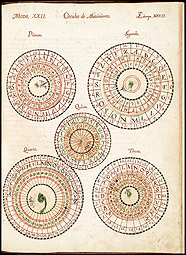
 |
 |
Encoding Machines, Spain, ca. 1600
|
 |
Most disciplines and sciences proliferated openly, spurred by the success of their practical applications. Others were preserved and passed on behind a veil of secrecy. Alchemy, the forerunner of chemistry, deliberately shrouded the mastery of its discipline in mysterious origins. The need to know and protect sensitive, classified information rendered knowledge a valuable commodity in the worlds of both science and politics. Secret knowledge—its concealment, maintenance, and decoding—became both industry and art form.
In the image at right, revolving paper wheels, or volvelles, reveal the proper correspondence of letters to each other, but only if one knows the right combination. This mechanical technique is just one of the keys proposed in this manuscript about encrypting and decoding secret messages.
|
 |
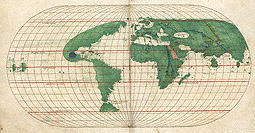
 |
 |
World Map, Battista Agnese, Venice, 1535–1538
|
 |
 |
The scientific art of representing the cosmos through astronomy and mathematics provided direction and orientation at the dawn of the Age of Discovery. Global exploration, however, inevitably gave rise to military confrontation. As colonial ambitions spread, political powers vied for control of limited resources, and the arts of warfare witnessed extraordinary advancements. Supremacy in military science facilitated mastery of the world by both scholars and soldiers, and human exploration transformed into global conquest.
A world map appended to a nautical atlas perfectly advertises the cutting-edge knowledge of the cartographer, Battista Agnese, who was one of the most sought-after makers of portolans, or nautical charts, throughout Renaissance Italy. On the map, South America is labeled the "mundus novus" (new world), and indicated at its southern tip is "el streto de ferna[n]do magalaes," or the Straits of Magellan, which had only been discovered approximately 15 years earlier in 1520.
|
 |


